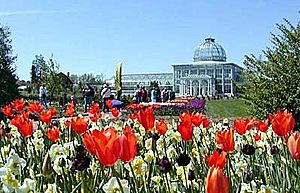Lewis Ginter Botanical Garden facts for kids
Lewis Ginter Botanical Garden is a beautiful botanical garden in Richmond, Virginia. It covers over 50 acres (200,000 m2) of land. This amazing garden has a large glass conservatory, a library cafe, and a tea house restaurant.
You can visit the garden for a small fee. Adults pay $14, seniors pay $11, and children aged 3-12 pay $8. Kids under 3 get in for free! The garden also has special free admission days. If your family has a SNAP/EBT card, you can get discounted tickets through the Museums for All program. Besides exploring the plants, you can enjoy art shows, special events, live music, tours, and classes.
Contents
Discover the Garden's Past
How the Land Became a Garden
Long ago, this land was a hunting ground for the Powhatan Indians. Later, in 1786, it was owned by Patrick Henry, who was a famous governor of Virginia.
In 1884, a businessman from Richmond named Lewis Ginter bought 10 acres (4.0 ha) of this land. He built a place called the Lakeside Wheel Club. This club was for people who loved riding bicycles. But the bicycle craze didn't last long, so the club closed after only a few years.
A Home and a Dream
After Lewis Ginter passed away in 1897, his niece, Grace Arents, bought the property. In 1912, she turned the old club cottage into a special hospital for babies called the Lakeside Sanatorium for Babies.
After two years, Grace Arents made the cottage her own home. She lived there with her friend, Mary Garland Smith. They named their home Bloemendaal House, which means "valley of flowers." This name honored Grace's family, who had Dutch heritage. Grace bought more land, making the property 73 acres (30 ha) in total. She traveled the world, bringing back many different plants for her home.
Mary Garland Smith continued to live at Bloemendaal House after Grace Arents died in 1926. Mary lived there until she was 100 years old! Grace Arents had a special wish in her will. She wanted the property to become a botanical garden to honor her uncle, Lewis Ginter.
Building the Botanical Garden
For 13 years, the city of Richmond used the land as a tree nursery. They grew plants there for city parks. Finally, in 1981, a non-profit group called the Lewis Ginter Botanical Garden corporation was created. Their goal was to build the botanical garden using money from Grace Arents' trust.
More land was bought, and in 1987, a landscape design company was hired. They created a big plan for how the gardens would look. The Lewis Ginter Botanical Garden officially opened in 1984. In 2017, readers of Conde Nast magazine and USA Today voted it one of the most beautiful gardens!
What You Can See Today
Amazing Buildings and Gardens
A big project finished in 2004 helped build many of the garden's main facilities. These include places for growing plants, learning, and community events. Some important buildings are:
- The Robins Visitors Center (built in 1999)
- Massey Greenhouses (built in 1999)
- Education and Library Complex (built in 2002)
- The beautiful glass-domed Conservatory (built in 2003)
- The Children's Garden (built in 2005)
Learning and Nature
The Education and Library Complex opened in 2002. This allowed the garden to offer many more learning programs. These programs teach people about plants and nature. Since the complex opened, many more people have signed up for the garden's classes.
Lewis Ginter Botanical Garden also works with universities. Students from the University of Richmond take landscape design classes here. Virginia Commonwealth University keeps its collection of dried plant specimens (called an herbarium) at the garden. This collection helps with a big project to list all the plants in Virginia. The garden also works with Virginia Tech to find and grow new and interesting plants that grow well in Virginia.
Fun Events All Year
Exciting Things to Do
Lewis Ginter Botanical Garden hosts many fun events throughout the year:
- During the winter holidays, they have the GardenFest of Lights. This event features thousands of twinkling lights and draws many visitors.
- In the spring, summer, and early fall, you can see hundreds of live tropical butterflies in the conservatory. It's like stepping into a butterfly paradise!
- In the spring, the garden also offers concerts and special Easter-themed activities for children.
Gallery
See also
 In Spanish: Jardín botánico Lewis Ginter para niños
In Spanish: Jardín botánico Lewis Ginter para niños





